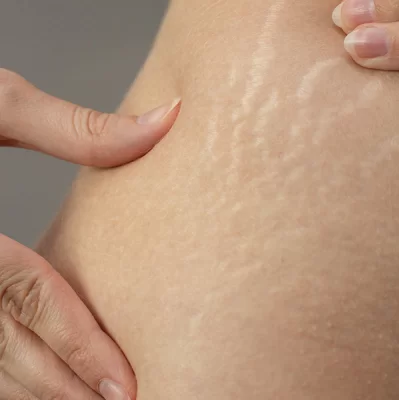Stretch marks during pregnancy
- What are stretch marks during pregnancy and why do they occur?
- How to prevent stretch marks during pregnancy?
- What cosmetics to choose for stretch marks during pregnancy?
- How to properly care for the skin during pregnancy?
- What home remedies help with stretch marks?
- Which cosmetic treatments reduce the visibility of stretch marks after pregnancy?
- Which is more effective for stretch marks: creams or professional treatments?
Pregnancy stretch marks are spindle-shaped scars that form on the skin as a result of excessive stretching. They most commonly appear on the abdomen, breasts, thighs, and buttocks. Their occurrence in pregnant women is closely related to hormonal changes. A key role is played by the increase in cortisol, estrogens, and relaxin, which weaken fibroblasts - the cells responsible for collagen and elastin production. As a result, the collagen network in the skin develops tears, and the skin loses its elasticity.
The main risk factors for developing stretch marks include rapid weight gain, genetic predisposition, high pre-pregnancy BMI, and young age of the mother-to-be.
Stretch marks have two characteristic phases. Initially, in the inflammatory phase, they are red and may cause itching. Over time, they transition into the atrophic phase, becoming paler and taking on a pearly hue.
To effectively prevent the formation of stretch marks during pregnancy, it is essential to support the skin, as collagen and elastin fibers are naturally weakened.
Regular monitoring of weight gain under the supervision of a doctor is extremely important, as it helps minimize excessive stretching of the skin.
Skin condition is significantly improved by a balanced diet and proper hydration. Important components in the diet include:
- vitamin A,
- vitamin C,
- vitamin E,
- zinc,
- silicon,
- omega-3 fatty acids,
- omega-6 fatty acids.
Moderate physical activity such as prenatal yoga, swimming, or Pilates also brings benefits. These forms of exercise not only improve circulation but also increase skin elasticity.
All these healthy habits significantly support the skin of the future mother, effectively reducing the risk of unwanted stretch marks.
To effectively care for the skin and prevent the formation of stretch marks, it is crucial to use firming cosmetics. These products, including creams, balms, ointments, and oils, must intensely moisturize the skin. Their effectiveness is based on active ingredients, especially of plant origin, which support the natural production of collagen and elastin. Among the particularly valuable components of cosmetics that will help your skin are:
- Centella asiatica,
- Aloe vera,
- Witch hazel,
- Polyphenols,
- Wakame algae,
- Hyaluronic acid,
- Panthenol,
- Shea butter,
- Cocoa butter,
- Sweet almond oil,
- Jojoba oil,
- Argan oil,
- Avocado oil,
- Coconut oil,
- Flaxseed oil,
- Olive oil,
- Rosehip oil.
Skin care during pregnancy requires consistency. Regular moisturizing is extremely important as it supports skin regeneration. It is best to apply cosmetics twice a day, especially after a bath, when the skin absorbs active ingredients most easily.
Each application of cosmetics should be combined with a gentle massage. Perform it with circular movements. You can also lightly pinch the skin to stimulate blood circulation. Do not forget about regular exfoliation of the epidermis. Scrubs should be done once or twice a week. Dry brushing will be a great addition to your skincare routine.
Such comprehensive care helps to alleviate the bothersome itching and tingling of the skin, often occurring during pregnancy.
Home remedies for stretch marks are a valuable addition to professional care, especially after pregnancy, supporting skin regeneration and increasing elasticity. Regular massages with natural oils, such as argan or almond oil, improve blood circulation. Additionally, a massage with a Chinese cup intensively stimulates connective tissue. The whole routine can be complemented by homemade coffee or sugar scrubs, which smooth the epidermis and support its renewal.
After the hardships of pregnancy, childbirth, and lactation, it's worth paying attention to your skin. It is precisely at that time that professional treatments can significantly reduce the visibility of stretch marks.
One of the most effective methods for reducing stretch marks is laser therapy. Fractional laser, through stimulating the production of new collagen, perfectly smoothes the skin's surface.
Equally helpful is mesotherapy - both microneedle and needle-free. Both techniques effectively introduce valuable nutrients into deeper layers of the skin.
Microdermabrasion and chemical peels are additional methods that effectively exfoliate the epidermis, helping to smooth out any unevenness and scars.
Other available methods for eliminating stretch marks include carboxytherapy, radio waves, ultrasound, as well as innovative treatments with platelet-rich plasma.
When stretch marks are particularly visible, there is also the option of masking them, for example, through specialized tattoos.
The effectiveness of reducing stretch marks is closely related to their phase and size. In everyday skincare, creams that effectively prevent the formation of new marks work well. They are particularly effective in fighting red, fresh stretch marks — supporting the healing and renewal process of the skin.
Professional cosmetic treatments focus on combating established, white scars. Their goal is the deep reconstruction of the skin's structure, making stretch marks significantly less visible. However, the best results are achieved by combining various methods of action. It is recommended to intensively prevent stretch marks during pregnancy, and after childbirth, special treatments should be considered if needed.

